
Georg Heinrich Crola (6 June 1804, Dresden - 6 May 1879, Ilsenburg am Harz) was a German landscape painter in the mid-19th century. He specialized in the representation of the German forest.

Georg Heinrich Crola (6 June 1804, Dresden - 6 May 1879, Ilsenburg am Harz) was a German landscape painter in the mid-19th century. He specialized in the representation of the German forest.
Georg Heinrich Crola was born in Dresden in 1804, the son of the merchant Croll. Difficult domestic conditions forced his parents to send the four year-old Georg Heinrich to live in the family of his maternal grandfather, who was a painter at the Royal Porcelain Factory and an art teacher at the state boarding school of Meissen. His grandfather, recognising his artistic talent, introduced him in Dresden to the painters Johann Christian Klengel, Johann David Schubert and Johann Gottfried Jentzsch who took charge of his education. [1]
After the death of his grandfather in 1822 he lived for a while a wandering life. Around this time he also changed his family name from Croll to Crola so as to avoid conscription by the Saxon government. Around 1823 he was back in Dresden where he made a living from painting boxes. He succeeded in capturing the attention of Caspar David Friedrich and Johan Christian Dahl who assisted him in his studies. His talent was also recognised by Ernest I, Duke of Saxe-Coburg and Gotha who gave him commissions to paint landscapes and castles in Gotha. He used the opportunity to paint many landscapes of the Gotha region. [2]

Crola went to Munich in 1830, where he studied the old masters as well as the neighboring landscapes. He traveled later to northern Germany where he got to know work of the Düsseldorf school of painting.
He later visited Berlin where he met his future bride Elise (Elisabeth) Concordia, daughter of a banker and an amateur painter herself. The couple got married in 1840 in Ilsenburg and the couple settled there. The pair founded a school for romantic landscape painters.
From that time onwards the surrounding low mountains became Crola's most important source of inspiration. [1]

Adam Friedrich Oeser was a German etcher, painter and sculptor.
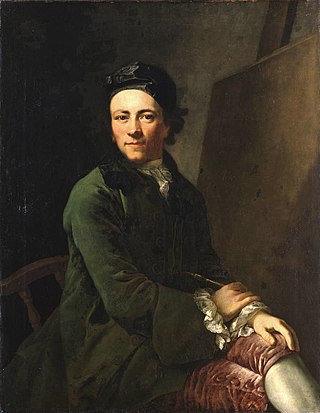
Anton Graff was an eminent Swiss portrait artist. Among his famous subjects were Friedrich Schiller, Christoph Willibald Gluck, Heinrich von Kleist, Frederick the Great, Friederike Sophie Seyler, Johann Gottfried Herder, Gotthold Ephraim Lessing, Moses Mendelssohn and Christian Felix Weiße. His pupils included Emma Körner, Philipp Otto Runge and Karl Ludwig Kaaz.
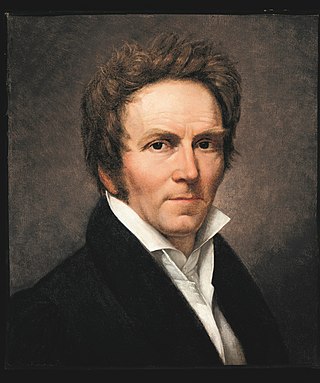
Johan Ludwig Gebhard Lund was a Danish painter, born in Kiel, Duchy of Holstein, to master painter Hans Giewert Lund and his wife Maria Magdalena Christina Bremer. An adherent of romanticism, he is known for his history paintings.
The Düsseldorf School of painting is a term referring to a group of painters who taught or studied at the Düsseldorf Academy roughly between 1819 and 1918, first directed by the painter Wilhelm von Schadow.

Eduard Julius Friedrich Bendemann was a German-Jewish painter.

Johann Michael Ferdinand Heinrich Hofmann was a German painter of the late 19th to early 20th century. He was the uncle of the German painter Ludwig von Hofmann. He was born in Darmstadt and died in Dresden. He is best known for his many paintings depicting the life of Jesus Christ.

Karl Friedrich Lessing was a German historical and landscape painter, grandnephew of Gotthold Ephraim Lessing and one of the main exponents of the Düsseldorf school of painting.

Elias Gottlob Haussmann was a German painter in the late Baroque era. Haussmann served as court painter at Dresden, and from 1720, as the official portraitist at Leipzig. He is mostly known for his portrait of Johann Sebastian Bach which was painted in 1746.

Otto Magnus Freiherr von Stackelberg was a Baltic German, Imperial Russian archaeologist, as well as a writer, painter and art historian.
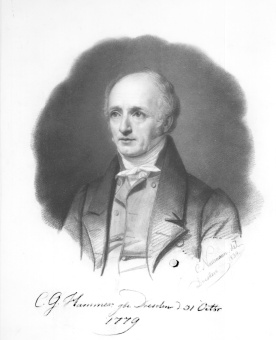
Christian Gottlob Hammer, baptized as Gottlieb,, was an influential German landscape painter and engraver.

Johann Christian Reinhart was a German painter and engraver. He was one of the founders, along with Joseph Anton Koch, of German romantic classical landscape painting.

The Weimar Princely Free Drawing School was an art and literature educational establishment. It was set up in 1776 in Weimar by the scholar and ducal private-secretary Friedrich Justin Bertuch (1747–1822) and the painter Georg Melchior Kraus (1737–1806), as part of Weimar Classicism. It was financed by the young Charles Augustus, Grand Duke of Saxe-Weimar-Eisenach and heavily promoted by Goethe, who also taught there. Among its pupils were Charles Augustus's future mistress Karoline Jagemann. It lasted until 1930.
Louise Seidler was a German painter at the court of the grand dukes of Weimar, custodian of their art collection and a trusted friend of the poet Goethe and the painter Georg Friedrich Kersting.

Emma Sophie Körner was a German painter, a pupil of the Swiss painter Anton Graff, and sister of the poet and soldier Carl Theodor Körner.

Johann Eleazar Zeissig, also known as Schenau, was a German genre, portrait and porcelain painter, and engraver; director of the Royal Academy of Arts in Dresden.
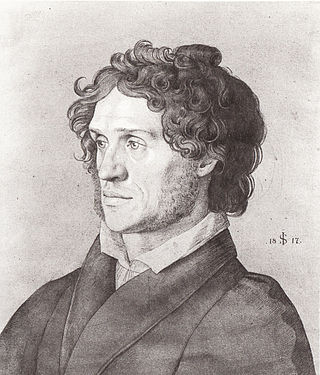
Johann Heinrich Ferdinand Olivier (1785–1841) was a German painter associated with the Nazarene movement.
Friedrich Ludwig Heinrich Waagen also Christian Friedrich Ludwig Heinrich Waagen, Wagen or Wage) was a German portrait, history and landscape painter. Hardly anything is known about his works. However, he had acquired extensive knowledge of art, amassed a collection of paintings in Hamburg and was known to friends with or in-laws of many important personalities of his time. Gustav Friedrich Waagen (1794-1868) and Carl Waagen (1800-1873) are his sons.

Willy Spatz was a German painter and lithographer.
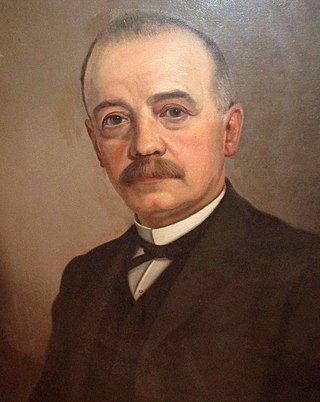
Meinrad Iten was a Swiss portrait and landscape painter; associated with the Düsseldorfer Malerschule.
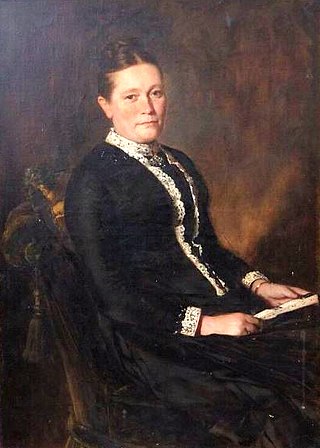
Hugo Crola was a German portrait, landscape and genre painter, associated with the Düsseldorfer Malerschule.